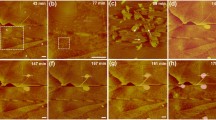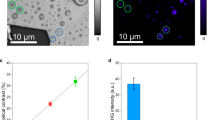Abstract
When a liquid makes contact with a solid wall, theoretical studies1,2,3,4 indicate that the atoms or molecules will become layered adjacent to the wall, giving rise to an oscillatory density profile. This expectation has not, however, been directly verified, although an oscillatory force curve is seen for liquids compressed between solid surfaces5. Here we present the results of an X-ray scattering study of liquid gallium metal in contact with a (111) diamond surface. We see pronounced layering in the liquid density profile which decays exponentially with increasing distance from the wall. The layer spacing is about 3.8 å, which is equal to the repeat distance of (001) planes of upright gallium dimers in solid α-gallium. Thus it appears that the liquid near thewall assumes a solid-like structure similar to the α-phase, which is nucleated on freezing at lower temperatures. This kind of ordering should significantly influence flow, capillary osmosis, lubrication and wetting properties5,6, and is likely to trigger heterogeneous nucleation of the solid.


Similar content being viewed by others
References
McMullen, W. E. & Oxtoby, D. W. Adensity functional approach to freezing transitions in molecular fluids: dipolar hard spheres. J. Chem. Phys. 88, 4146–4156 (1987).
Curtin, W. A. Density-functional theory of the solid–liquid interface. Phys. Rev. Lett. 59, 1228–1231 (1987).
Sikkenk, J. H., Indekeu, J. O., van Leeuwen, J. M. J. & Vossnack, E. O. Molecular-dynamics simulation of wetting and drying at solid–fluid interfaces. Phys. Rev. Lett. 59, 98–101 (1987).
Ma, W.-J., Banavar, J. R. & Koplik, J. Amolecular dynamics study of freezing in a confined liquid. J. Chem. Phys. 97, 485–493 (1992).
Bhushan, B., Israelachvili, J. N. & Landman, U. Nanotribology: friction, wear and lubrication at the atomic scale. Nature 374, 607–609 (1995).
Derjaguin, B. V. & Churaev, N. V. Structure of the boundary layers of liquids and its influence on the mass transfer in fine pores. Progr. Surf. Mem. Sci. 14, 69–130 (1981).
Toney, M. F. et al . Voltage-dependent ordering of water molecules at an electrode–electrolyte interface. Nature 368, 444–446 (1994).
Barton, S. W. et al . Distribution of atoms at the surface of liquid mercury. Nature 321, 685–687 (1986).
Magnussen, O. M. et al . X-ray reflectivity measurements of surface layering in liquid mercury. Phys. Rev. Lett. 74, 4444–4447 (1995).
Regan, M. J. et al . Surface layering in liquid gallium: an X-ray reflectivity study. Phys. Rev. Lett. 75, 2498–2502 (1995).
Pate, B. B. The diamond surface: atomic and electronic structure. Surf. Sci. 165, 83–142 (1986).
Derry, T. E., Smit, L. & van der Veen, J. F. Ion-scattering determination of the atomic arrangement at polished diamond(111) surfaces before and after reconstruction. Surf. Sci. 167, 502–518 (1986).
Norris, C. & Wotherspoon, J. T. M. The optical density of states of liquid gallium. J. Phys. F7, 1599–1606 (1977).
Grübel, G., Als-Nielsen, J. & Freund, A. K. The Troika beamline at ESRF. J. Physique IV 4, C9, 27–34 (1994).
Vlieg, E. Integrated intensities using a six-circle X-ray diffractometer. J. Appl. Crystallogr. 30, 532–543 (1997)).
Lagally, M. G., Savage, D. E. & Tringides, M. C. in Reflection high-energy electron diffraction and reflection imaging of surfaces 139–174 (Plenum, New York, (1988)).
Defrain, A. États métastables du gallium. Surfusion et polymorphisme. J. Chim. Phys. 74, 851–862 (1977).
Narten, A. H. Liquid gallium: comparison of X-ray data and neutron-diffraction data. J. Chim. Phys. 56, 1185–1189 (1972).
Gong, X. G., Chiarlotti, G., Parrinello, M. & Tosatti, E. Coexistence of monoatomic and diatomic molecular fluid character in liquid gallium. Europhys. Lett. 21, 469–475 (1993).
Trittibach, R., Grütter, Ch. & Bilgram, J. H. Surface melting of gallium single crystals. Phys. Rev. B50, 2529–2536 (1994).
Züger, O. & Dürig, U. Atomic structure of the α-Ga(001) surface investigated by STM: direct evidence for the existence of Ga2molecules in solid gallium. Ultramicroscopy 42–44, 520–527 (1992).
Turnbull, D. Formation of crystal nuclei in liquid metals. J. Appl. Phys. 21, 1022–1028 (1950).
Van der Veen, J. F., Pluis, B. & Denier van der Gon, A. W. in Chemistry and Physics of Solid Surfaces VII 455–490 (Springer, Berlin, (1988)).
Turnbull, D. in Physics of Non-crystalline Solids 41–56 (North-Holland, Amsterdam, (1964)).
Rice, S. A., Gryko, J. & Mohanty, U. in Fluid Interfacial Phenomena 255–342 (Wiley, Chichester, (1986)).
Huisman, W. J. et al . Anew X-ray diffraction method for structural investigations of solid-liquid interfaces. Rev. Sci. Instrum. 68, 4169–4176 (1997).
Huisman, W. J. et al . Evidence for tilted chains on the diamond(111)-2 × 1 surface. Surf. Sci.(in the press).
Acknowledgements
We thank C. Norris of the University of Leicester for introducing us to his technique of producing clean Ga droplets. We also acknowledge De Beers Diamond Research Laboratories of Johannesburg for the provision of the specimen and M. Rebak of the Schonland Research Center for polishing the crystal. This work is part of the research programme of the Foundation for Fundamental Research on Matter (FOM) and was made possible by financial support from the Netherlands Organisation for Scientific Research (NWO).
Author information
Authors and Affiliations
Corresponding author
Rights and permissions
About this article
Cite this article
Huisman, W., Peters, J., Zwanenburg, M. et al. Layering of a liquid metal in contact with a hard wall. Nature 390, 379–381 (1997). https://doi.org/10.1038/37069
Received:
Accepted:
Issue Date:
DOI: https://doi.org/10.1038/37069
- Springer Nature Limited
This article is cited by
-
Crystallization of molecular layers produced under confinement onto a surface
Nature Communications (2024)
-
Heterogeneous Nucleation During Solidification
Metal Science and Heat Treatment (2023)
-
Unique surface patterns emerging during solidification of liquid metal alloys
Nature Nanotechnology (2021)
-
Bubbles to Chondrites-I. Evaporation and condensation experiments, and formation of chondrules
Progress in Earth and Planetary Science (2020)
-
Uncovering the effects of interface-induced ordering of liquid on crystal growth using machine learning
Nature Communications (2020)





